Centauri Dreams
Imagining and Planning Interstellar Exploration
Pluto as ‘Planet’
I have never been exactly indignant about the demotion of Pluto to ‘dwarf planet’ status but I do think it’s curious and in at least one respect too arbitrary for my taste. I’ll buy the idea that a planet needs to be round because of its own gravity, and I’ll sign off on the notion that to be a planet, an object has to be in orbit around the Sun (even though we do have apparent wandering planets in the interstellar deep, far from any star). But the International Astronomical Union also decided in its 2006 deliberations that a planet has to ‘clear’ its neighborhood of debris, thus sweeping out its orbit over time. That one, of course, is controversial.
Assuming the Earth is a planet, why are we worried about things like Near Earth Asteroids (NEAs)? Our planet clearly hasn’t swept out its neighborhood, not when we can number problematic asteroids in the thousands. Jupiter is estimated to have about 100,000 trojan asteroids in its orbital path as well, and Alan Stern, principal investigator for New Horizons, has pointed out on more than one occasion that if Neptune (obviously a planet) had cleared its orbit, Pluto itself wouldn’t be there, and the whole discussion might never have come up.
For that matter, we would not be having this discussion now if not for continuing discoveries in the Kuiper Belt that more or less force the issue. Eris was found in 2005, a world more massive than Pluto and first thought to be larger as well, leading to the temporary designation of it as the ‘tenth planet,’ and raising the question of what to do about a Kuiper Belt that might be stuffed with such objects. Here the matter seems to be one of simple redundancy. Nine, or eight, planets, is acceptable. Several thousand is not — it seems to devalue the notion altogether.
I can see why working this out is still controversial. Meanwhile, from a purely aesthetic point of view, I have a hard time looking at the image below and seeing it as anything other than a planet. Or, as I have said before, the larger component of a binary planetary system.

Image: Just 15 minutes after its closest approach to Pluto on July 14, 2015, NASA’s New Horizons spacecraft looked back toward the sun and captured a near-sunset view of the rugged, icy mountains and flat ice plains extending to Pluto’s horizon. The smooth expanse of the informally named Sputnik Planum (right) is flanked to the west (left) by rugged mountains up to 3,500 meters high, including the informally named Norgay Montes in the foreground and Hillary Montes on the skyline. The backlighting highlights more than a dozen layers of haze in Pluto’s tenuous but distended atmosphere. The image was taken from a distance of 18,000 kilometers to Pluto; the scene is 380 kilometers across. Credit: NASA/Johns Hopkins University Applied Physics Laboratory/Southwest Research Institute.
We see mountains here, plains, glaciers, but what really catches the eye is the multi-layered haze in Pluto’s thin nitrogen atmosphere. Here we’re looking at more than a dozen such layers extending all the way from the surface up to 100 kilometers. Mountains falling into shadow at sunset and a bank of low-lying haze near the terminator give us the sense of looking at a place in a constant state of change, a world laden with active patterns of weather. We seem to have the Plutonian version of a ‘hydrological’ cycle here, substituting nitrogen for water ice.
“We did not expect to find hints of a nitrogen-based glacial cycle on Pluto operating in the frigid conditions of the outer solar system,” said Alan Howard, a member of the mission’s Geology, Geophysics and Imaging team from the University of Virginia, Charlottesville. “Driven by dim sunlight, this would be directly comparable to the hydrological cycle that feeds ice caps on Earth, where water is evaporated from the oceans, falls as snow, and returns to the seas through glacial flow.”
Call this world what you will, the imagery is getting better and better. Here are some recent releases.
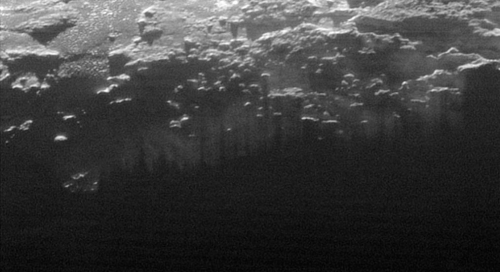
Image: In this small section of the larger crescent image of Pluto, taken by NASA’s New Horizons just 15 minutes after the spacecraft’s closest approach on July 14, 2015, the setting sun illuminates a fog or near-surface haze, which is cut by the parallel shadows of many local hills and small mountains. The image was taken from a distance of 18,000 kilometers, and the width of the image is 185 kilometers. Credit: NASA/Johns Hopkins University Applied Physics Laboratory/Southwest Research Institute.
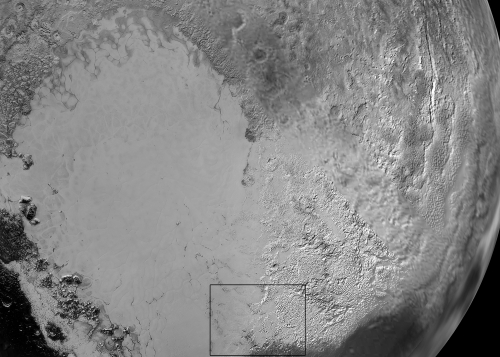
Image: Sputnik Planum is the informal name of the smooth, light-bulb shaped region on the left of this composite of several New Horizons images of Pluto. The brilliantly white upland region to the right may be coated by nitrogen ice that has been transported through the atmosphere from the surface of Sputnik Planum, and deposited on these uplands. Credit: NASA/Johns Hopkins University Applied Physics Laboratory/Southwest Research Institute.
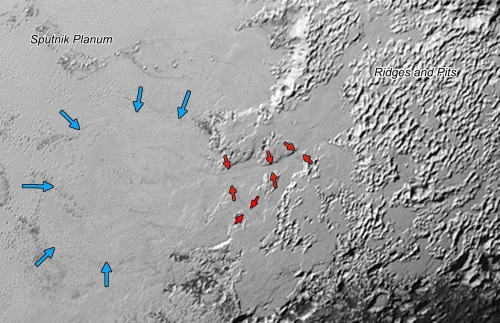
Image: Ice (probably frozen nitrogen) that appears to have accumulated on the uplands on the right side of this 630-kilometer wide image is draining from Pluto’s mountains onto the informally named Sputnik Planum through the 3- to 8- kilometer wide valleys indicated by the red arrows. The flow front of the ice moving into Sputnik Planum is outlined by the blue arrows. The origin of the ridges and pits on the right side of the image remains uncertain. Credit: NASA/Johns Hopkins University Applied Physics Laboratory/Southwest Research Institute.
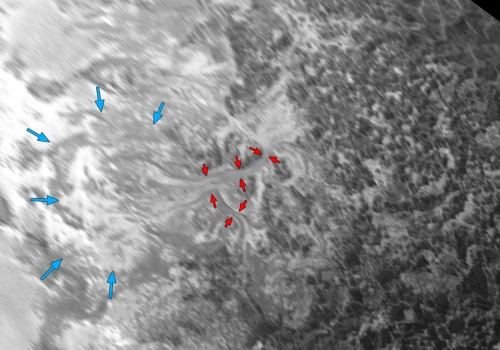
Image: This image covers the same region as the image above, but is re-projected from the oblique, backlit view shown in the new crescent image of Pluto. The backlighting highlights the intricate flow lines on the glaciers. The flow front of the ice moving into the informally named Sputnik Planum is outlined by the blue arrows. The origin of the ridges and pits on the right side of the image remains uncertain. This image is 630 kilometers across. Credit: NASA/Johns Hopkins University Applied Physics Laboratory/Southwest Research Institute.

Greg Matloff: Conscious Stars Revisited
It’s no exaggeration to say that without Greg Matloff, there would have been no Centauri Dreams. After reading his The Starflight Handbook (Wiley, 1989) and returning to it for years, I began working on my own volume in 2001. Research for that book would reveal Matloff’s numerous contributions in the journals, especially on solar sail technologies, where he illustrated early on the methods and materials needed for interstellar applications. A professor of physics at New York City College of Technology (CUNY) as well as Hayden Associate at the American Museum of Natural History, Dr. Matloff is the author of, among others, Deep Space Probes (Springer, 2005) and Solar Sails: A Novel Approach to Interplanetary Travel (with Les Johnson and Giovanni Vulpetti; Copernicus, 2008). His latest, Starlight, Starbright, is now available from Curtis Press, treating the controversial subject of today’s essay.
by Greg Matloff
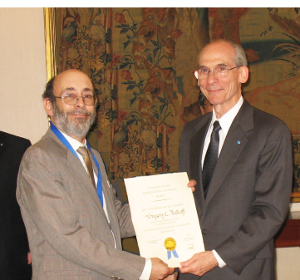
Introduction: Motivations
As any web search will reveal, most of my research contributions have been in the fields of in-space propulsion, SETI, Earth-protection from asteroid impacts, planetary atmospheres, extra-solar planet detection and spacecraft navigation. Since I have consulted for NASA on solar-sail applications, I have trained myself to err on the side of conservatism. However, a true scientist cannot ignore observational data. He or she must base hypothesis and theories upon such results, not upon previous experience, ideology and dogma.
Image: Gregory Matloff (left) being inducted into the International Academy of Astronautics by JPL’s Ed Stone.
Until 2011, I never expected that I might contribute to the fascinating debate regarding the origin and nature of consciousness. On one side are the epiphenomenonalists, who believe that consciousness is a mere byproduct of bio-chemical activity in the complex brains of higher organisms. On the other side are the panpsychists, who believe that a universal field responsible for consciousness, sometimes referred to as “proto-consciousness,” reacts with matter to produce conscious activity at all levels. The philosophical arguments were fascinating, but to me as a scientist they were a bit disappointing. There seemed to be no way of elevating the argument from the realm of deductive philosophy to the realm of observational/experimental science.
But in 2011, as documented in my June 12, 2012 contribution to this blog – Star Consciousness: An Alternative to Dark Matter – I learned (much to my surprise) that it may be possible now to construct simple models of universal consciousness and test them against observational evidence.
I was primed for this work by several factors. First, an early mentor of mine and a coauthor of several astronautics papers, was the late Evan Harris Walker. With expertise in plasma and quantum physics, Harris (as his friends called him) was a pioneer in the infant field of quantum consciousness. Although I am far from an expert in quantum mechanics, I was fascinated by Harris’ attempt to explain consciousness by the quantum tunneling of wave functions through potential wells created by the inter-synaptic spacing in mammal brains [1].
After the success of The Starflight Handbook and other contributions to interstellar travel studies, I was asked by Apollo 11 astronaut Buzz Aldrin in the early 1990’s to join the team of scientific consultants for a science-fiction novel he was co-authoring with John Barnes [2]. For plot purposes, Buzz required the stable, long-term existence of a Jupiter-like planet at a 1 Astronomical Unit (AU) distance from a Sun-like star. When he asked me to check the possibility of such a planet, I was initially very pessimistic. When I told Buzz that most exoplanet experts believed that the Hydrogen-Helium atmosphere of such a planet would likely evaporate quickly (in cosmic terms), he asked me to check this assumption. I located an appropriate equation in a space science handbook and calculated the estimated lifetime of the giant planet’s atmosphere. I was surprised and Buzz was gratified to learn that the lifetime of the Jovian’s atmosphere at 1 AU would be billions of years. At that point in my career, I was an adjunct professor and consultant. Since I was unable to locate a derivation for the subject equation, I elected not to challenge scientific orthodoxy and attempt to publish these results in a scientific journal. After the discovery of “hot Jupiters” circling Sunlike stars a few years later, I became credited (by Paul Gilster and others) with predicting the existence of hot Jupiters in a science-fiction novel, but not in a peer-reviewed journal. I vowed to never repeat this mistake again and hold back data, if my results challenged established paradigms.
The third influence pointing me in the direction of conscious stars was an undergraduate, liberal arts student at New York City College of Technology. Between the time I became a tenure-track professor in 2003 and my retirement from full-time teaching in 2011, I organized and coordinated the astronomy program at New York City College of Technology (NYCCT). In the first term of the NYCCT astronomy sequence, students learn about astronomical history, aspects of classical and modern physics and solar-system astronomy. In the second term, they investigate the astrophysics of the Sun, stars, and galaxies, cosmology, and the prospects for extraterrestrial life. In one Astronomy 2 section, I was lecturing about dark matter. The existence of this mysterious substance has been invited to explain anomalous stellar motions. When a liberal arts undergraduate interrupted the lecture, I learned that he doubted dark matter’s existence. His supposition was that physics is at an analogous stage to the situation in 1900. A major shift in physical paradigms may be necessary to explain the many anomalies (including dark matter) building up in observational astrophysics.
In 2011, it all came together. Kelvin Long, who edits the Journal of the British Interplanetary Society (JBIS), invited me to participate in a one-day symposium at the London headquarters of the BIS to celebrate the work of Olaf Stapledon, a British science-fiction author and philosopher who has greatly influenced astronomical and astronautical thought. In his 1937 masterwork Star Maker, Stapledon predicted nuclear energy, nuclear war, interstellar travel, space habitats and rearrangement of solar systems by intelligent extraterrestrials. Because I usually author papers on these topics and have often cited Star Maker, I elected to avoid astrotechnology in my contribution to this BIS symposium and instead concentrate on a core aspect of Stapledon’s philosophy: that the stars and indeed the entire universe are in some sense conscious.
A Toy Model of Stellar Consciousness and Astrophysical Evidence
Many people have written about consciousness. Since there is no agreed upon definition of this quality, I decided to investigate a symptom of stellar consciousness. This is Stapleton’s supposition that a fraction of stellar motions around the centers of their galaxies is volitional. According to Stapledon, stars obey the canons of a cosmic dance as they travel through space. Many researchers consider the seat of consciousness in humans and other lifeforms to be neurons or tubules [1,3,4]. I have little knowledge regarding the intimate details of the stellar interior. But I am pretty sure that neurons and tubules do not exist within stars. However, most cooler stars, including the Sun, do have simple molecules in their upper layers.
Contrary to what many of us learned in high school chemistry, the Van der Waals forces that hold the atoms in molecules together are not purely electromagnetic. Some of this attraction is due to the so-called Casimir Effect [5]. Vacuum is not truly empty. Instead, in tiny intervals of space and time, there are enormous fluctuations of energy and matter. Generally, positive and negative energies in these fluctuations exactly balance. But in the opinion of most cosmologists, the Big Bang was a stabilized vacuum fluctuation. All the matter, energy, space and time in the universe inflated from a tiny volume of dynamic vacuum during this event.
An echo of this most creative event in the universe’s history occurs in every molecule. Not all vacuum fluctuations can fit between adjacent molecules. A fraction of the Van der Waals force holding molecules together is produced by the pressure of these vacuum fluctuations.
With astrophysicist Bernard Haisch [6], I assumed that a proto-consciousness field operates through vacuum fluctuations or is identical to these fluctuations. I developed a very simple “toy model” in which this field produces a form of primitive consciousness by its interaction with molecular matter in the Casimir Effect (Fig. 1).
Fig. 1. A “Toy Model” of Proto-Panpsychism.

But models, no matter how simple or complex, are useful in physics only if they can be validated through experiment or observation. So I conducted a Google search for “Star Kinematics Anomaly and Discontinuity”.
Contrary to my expectation, what appeared on my screen was amazing. There was a Soviet-era Russian astronomer named Pavel Parenago (1906-1960). In addition to his astronomical contributions, Dr. Parenago was a very clever man. Unlike many of his colleagues, he avoided an extended vacation in a very cold place by dedicating a monograph to the most highly evolved human of all times – Joseph Stalin!
The anomaly named after Parenago, which is referred to as “Parenago’s Discontinuity”—is his observation that cool, low-mass stars in our galactic vicinity (such as the Sun) move around the center of the Milky Way galaxy a bit faster than their hotter, higher-mass sisters.
I used two sources to quantify Parenago’s Discontinuity for nearby main sequence stars. One was a chapter in Allen’s Astrophysical Quantities, a standard reference in astrophysics [7]. The second was a compilation of observations of 5610 main sequence stars using the European Space Agency (ESA) Hipparcos space observatory out to a distance of ~260 light years [8]. Figure 2, a graph presenting this data, is also included in my June 12, 2012 contribution to this blog and the JBIS paper based on my contribution to the BIS Stapledon symposium [9].
In Fig. 2, star motion in the direction of galactic rotation is plotted against star (B-V) color index, which is a measure of the difference between star radiant output in the blue range of the spectrum and the center of the human eye’s visual sensitivity. Hot, blue, massive stars have low and negative (B-V) color indices. From Table 19.1 of Ref. 7, G spectral class main sequence stars such as the Sun have (B-V) color indices in the range of about 0.6-0.7.
Fig 2: Solar Motion in Direction of Galactic Rotation (V) for Main Sequence Stars vs. Star Color Index (B-V). Diamond Data Points are from Gilmore & Zelik. Square. Data Points are from Binney et al.
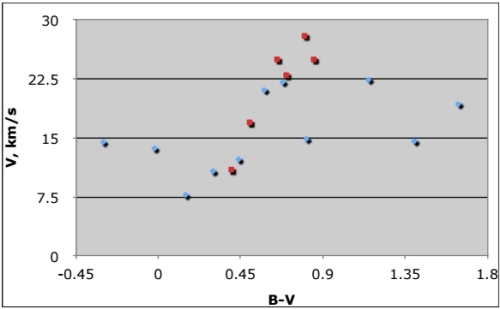
Note in Fig. 2 that cooler stars to the right of the discontinuity move as much as ~20 kilometers per second faster than their hotter sisters around the center of the galaxy. As discussed in the June 12, 2012 contribution to this blog and in Ref. 9, Parenago’s Discontinuity occurs near the point where stable molecules begin to appear in stellar spectra.
Recent Work and Consideration of Alternative Hypotheses
Science is essentially a testing ground of alternative hypotheses to explain observational and experimental data. Since data points to at least the local reality of Parenago’s Discontinuity, some astrophysicists have developed rival explanations to Volitional Stars.
One possibility is stellar boil-off from local stellar nurseries. Perhaps this results in faster motions for cooler, low mass stars. But this process should result in a greater velocity dispersion in low mass stars, not a higher velocity of revolution around the galaxy’s center. Also, stellar nurseries typically live for tens of millions of years [10]. Why is there no discontinuity in the motions of short-lived O and B stars?
If Parenago’s Discontinuity is a local phenomena extending out a few hundred light years from the Sun, at least one other alternative explanation is possible. This is the Spiral Arms Density Waves concept [11]. The matter density of the interstellar medium is not uniform. Although the typical density of ions and neutral atoms in the Sun’s vicinity (the so-called Intercloud Medium) is less than 0.1 per cubic centimeter, matter density in the cooler, mostly neutral diffuse nebula that operate as stellar nurseries in the spiral arms of our galaxy is orders of magnitude greater. If a dense diffuse nebula passed through our galactic vicinity in the distant past, low-mass, cool, redder stars might be dragged along faster by the dense cloud than hot, blue, more massive stars.
There are at least two ways to check the validity of the Spiral Arms Density Waves hypothesis. One is to investigate the typical size of diffuse nebula in the Milky Way galaxy. The second is to check observational consequences of this hypothesis.
In a recent book, I reviewed the sizes of diffuse nebula in Messier’s compilation [12]. As part of a recent research paper, I performed a similar review of the more comprehensive Herschel catalog and an on-line listing of New General Catalog (NGC) deep-sky objects [13]. These results are summarized in Fig. 3.
Fig 3: Fraction of Galactic Bright Diffuse Nebulae with Diameters > D Light Years from Messier (Blue), Herschel (Green) and Atlas of the Universe—NGC (Yellow) Compilations.

Note in Fig. 3 that, in all three compilations of deep-sky objects, diffuse nebulae with diameters greater than a few hundred light years are rare. Since the Hipparcos main sequence dataset used in Ref. 8 includes stars in a ~500 light year diameter sphere, Fig. 3 does not support the Spiral Arms Density Wave hypothesis.
But there is worse news for this hypothesis, also derived from Hipparcos data. Giant stars are considerably brighter than their less evolved counterparts on the main sequence and
are consequently visible over greater distances. Richard Branham, an astrophysicist based in Argentina, has analyzed the kinematics of thousands of giant stars in the Hipparcos data set [14]. His conclusion that Parenago’s Discontinuity is present in these results is demonstrated in Fig. 4.
Fig 4: Giant Star Motion (V) in Direction of Sun’s Galactic Revolution. The reduction of Branham’s data to produce Fig. 4 is discussed in Chap. 23 of Ref. 12.
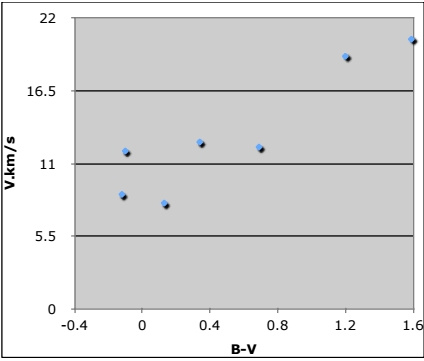
Note that Fig. 4 is not as neat as the corresponding results for main sequence stars in Fig. 2. This may be due to uncertainty in the > 1,000 light year distance estimates for many of the stars in Branham’s Sample.
An interpretation of the above results is that a local explanation for Parenago’s Discontinuity is unlikely. Existing galactic diffuse nebula are simply too small (and widely separated, as discussed in Ref. 12) to produce a stellar kinematics anomaly over a radius greater than 1,000 light years.
However, although the existing data does not support Spiral Arms Density Waves, the sample of stars, which numbers in the thousands, is not large enough to rule out this and other local explanations for Parenago’s Discontinuity. After all, the Milky Way galaxy contains more than a hundred billion stars.
Within the next few years, astrophysicists should know conclusively whether Parenago’s Discontinuity is a local or galactic phenomenon. In December 2013, the European Space Agency (ESA) launched Gaia as a more capable successor to the Hipparcos space observatory. While Hippasrcos accurately determined the distance and motions of perhaps 100,000 stars,
Gaia should gather similar data over the next few years for about a billion stars in the Milky Way galaxy. Gaia, its mission and capabilities are discussed in more detail in Ref. 12.
Fig 5: The European Space Agency’s Gaia Space Observatory (Courtesy ESA).
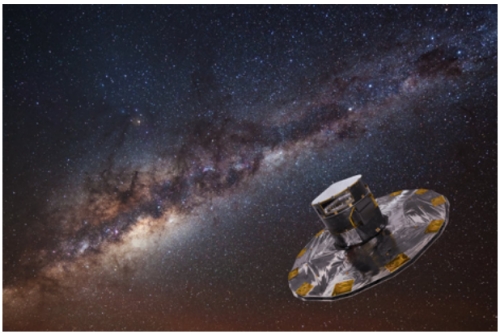
But even before the data from Gaia is analyzed and released, astronomers using different equipment have gathered preliminary data that may lead to the falsification of the Spiral Arms Density Waves hypothesis. Note in Fig. 6 the structure of M51, a typical nearby spiral galaxy not dissimilar from the Milky Way. The revolution of this galaxy is in the counterclockwise direction, from our point of view. Hundreds of millions of years are required for one
complete revolution [15].
A team of astronomers have carefully analyzed the light received from the leading and lagging edges of spiral arms of twelve nearby spiral galaxies. For the Spiral Arms Density Waves Hypothesis to be correct, differences should be observable between these two locations. Sadly for Density Waves (and happily for Volitional Stars), such an effect was not noticed.
Fig 6: The Whirlpool Galaxy M51 (courtesy NASA).
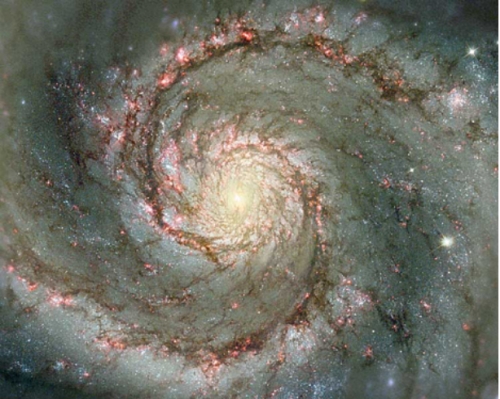
Since the universe contains ~100 billion spiral galaxies, this result is not conclusive. Using new telescopes, about 300 spirals should be observed to statistically rule out Density Waves. Density Waves is apparently limping, but it cannot yet be completely ruled out.
If observations from Gaia indicate that Parenago’s Discontinuity is a galactic phenomenon rather than a local phenomenon, some astrophysicists will attempt to develop explanations that are alternatives to Volitional Stars. As discussed in Ref. 13, this will be challenging. The only reasonable galaxy-wide explanation might be a collision between the Milky Way galaxy and another large galaxy in the distant past. While such a collision might have produced a galaxy-wide “starburst” episode of rapid star formation, simulations indicate that the ultimate result of such galaxy smash-ups is a giant elliptical galaxy, not a spiral such as the Milky Way.
Volitional Star Kinematics
In my June 12, 2012 contribution to this blog, I considered methods that a volitional star could use to adjust its galactic velocity. One possibility was stellar jets.
Many infant stars eject high-velocity matter streams (Fig. 7). Surprisingly, some of them are unipolar or unidirectional, ejecting more material in one direction than others [16]. In April 2015, Paul Gilster e-mailed a link indicating that solar winds from mature stars like the Sun
enter interstellar space in a complex system of jets [17]. The complexity of these jets is at least partially due to solar galactic motion and the interaction between the solar and galactic magnetic fields. Uni-directional matter jets from infant and young stars are discussed in greater detail in Chap. 15 of Ref. 12.
Fig 7: A Jet of High-Velocity Material Ejected From an Infant Star (courtesy NASA).
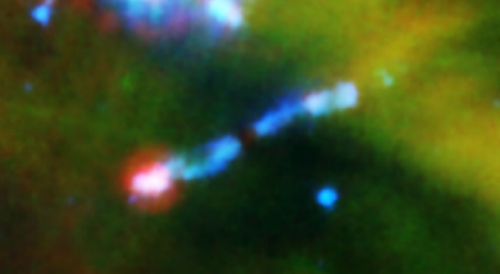
If Gaia observations reveal that Parenago’s Discontinuity is a galaxy-wide phenomenon, attention might turn to these unidirectional stellar jets. Are they generally aligned to accelerate molecule-bearing stars in the direction of their galactic motion? Since star galactic revolution velocities generally increase with distance from the galactic center, do jet velocities increase as well?
Although unidirectional material jets from infant and mature stars is one method that a volitional star could use, there is another possibility. This is the admittedly very controversial possibility of a weak psychokinetic (PK) force. Much has been written about the investigation of PK and related paranormal phenomena funded by US intelligence agencies.
As I have described in my earlier treatments of this subject, this is the only scientific controversy that I am privileged to know participants on opposing sides. On one hand are the physicists who claim that Uri Geller, the alleged psychic who scored best on their screening tests, could not possibly have cheated on these tests. On the other hand, I met a retired Time-Warner editor at a cocktail party years ago who demonstrated that Geller’s signature fork bending could be duplicated as a magic trick, and who also claimed to have enlisted a magician The Amazing Randi, to further investigate Geller.
Many web sources conclude that Geller is indeed a trained magician. When my friend Dr. Eric Davis of the Institute for Advanced Studies at Austin (Texas) mentioned (while reviewing a draft copy of Ref. 12) that there is no confirmation of Geller actually having attended a magician’s college, I decided to check what I consider the best reference available on the Geller-Randi controversy. I carefully checked a book by MIT physics professor David Kaiser on this topic and learned that Dr. Davis is apparently correct [18].
Eric Davis also sent me an electronic copy of a report he authored for the US Air Force in 2005. Many countries other than the US have investigated PK and related phenomena in studies funded by government agencies. Some of the results are positive and have reportedly been replicated [19, 20].
As discussed in Refs. 9 and 12 and my June 12, 2012 submission to this blog, a PK force required to accelerate a Sun-like star by 20 km/s during a ~1-billion-year time interval is many orders of magnitude less than that required to bend a kitchen utensil. Perhaps it is time for experimental physicists to put the Geller-Randi controversy aside and perform a new set of carefully controlled experiments to test the existence or non-existence of a weak PK effect.
One possibility discussed by others is to include professional magicians on the experiment design team. Another possibility, raised by a responder to my June 12, 2012 contribution to this blog, is to perform PK tests on the interaction between human subjects and an Einstein-Bose condensate. As further discussed in Ref. 12, an Einstein-Bose condensate is a macroscopic state of matter in which all of the particles share the same quantum state. A human subject might be instructed to see if he or she could “will” the condensate to climb the enclosure wall repeatedly to the same level. This would test not only the validity of PK but the assumption that consciousness is related to quantum phenomena.
Conclusions: A Learning Experience
Since 2011, I have spent a large fraction of my creative time investigating whether the Volitional Star hypothesis can be considered scientific. As reviewed in Ref. 12, it is certainly a venerable concept. Shamans, astrologers, philosophers, mystery-cult members, poets, and fiction authors have considered this possibility for millennia.
It is also interesting that at least a few scientists have walked this path before me. Although the concepts of stellar or universal consciousness are certainly not in the scientific mainstream at present, scientific speculation along these lines is becoming more respectable.
One creative group that apparently welcomes these concepts is fine artists. The chapter frontispiece art in Ref. 12 created by C Bangs has been presented in several artistic forums, including the Arts Program at the 9th IAA Symposium on the Future of Space Exploration, which was held in Turin, Italy in July 2015. A version of one of these images is presented as Fig. 8. Modifications of 18 of these images on 11″ X 14″ panels painted on both sides in the form of an accordion book are on display at the Manhattan gallery that C Bangs is affiliated with: Central Booking Art Space, 21 Ludlow Street.
Fig 8: Modified Version of C Bangs Chapter frontispiece from Starlight, Starbright.
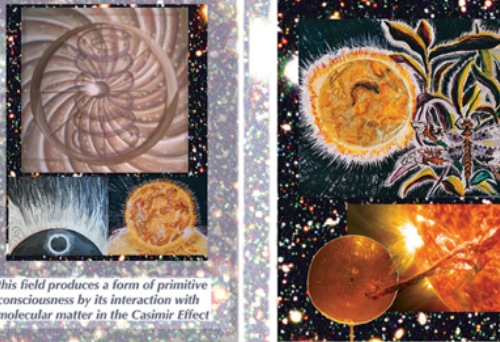
Recently, with my assistance, C prepared an Artist’s Book entitled Star Bright?. In July 2015, Star Bright? was collected by the Prints and Illustrated Books division of the Museum of Modern Art in Manhattan.
It is of course very premature to claim that the work presented here has proven the case for volitional stars. The toy model of proto-panpsychism is certainly too simple to have much traction in the theoretical world. But it is not impossible that this work might move panpsychism from the realm of deductive philosophy to the realm of observational astrophysics.
References
1. E. H. Walker, “The Nature of Consciousness,” Mathematical Biosciences, 7, 131-178 (1970). Also see E. H. Walker, The Physics of Consciousness, Perseus, Cambridge, MA (2000).
2. B. Aldrin and J. Barnes, Encounter with Tiber, Warner, NY (1996).
3. L. Margulis, “The Conscious Cell”, Annals of the New York Academy of Sciences, 929, 55-70 (2001).
4. S. Hameroff, “Consciousness, the Brain, and Spacetime Geometry”, Annals of the New York Academy of Sciences, 929, 74-104 (2001) and R. Penrose, “Consciousness, the Brain, and Spacetime Geometry: An Addendum”, Annals of the New York Academy of Sciences, 929, 105-110 (2001).
5. H. Genz, Nothingness: The Science of Empty Space, Perseus, Cambridge, MA (1999).
6. B. Haisch, The God Theory, Weiser, San Francisco, CA (2006).
7. G. F. Gilmore and M. Zelik, “Star Populations and the Solar Neighborhood,” in Allen’s Astrophysical Quantities, 4th ed. A. N. Cox ed., Springer-Verlag, NY (2000), Chap. 19.
8. J. J. Binney, W. Dehnen, N. Houk, C. A. Murray, and M. J. Preston, “Kinematics of Main Sequence Stars from Hipparcos Data,” Proceedings of the ESA Symposium Hipparcos Venice
’97, SP-402, Venice, Italy, 13-15 May 1997, pp. 473-477 (July, 1997).
9. G. L. Matloff, “Olaf Stapledon and Conscious Stars: Philosophy or Science?”, JBIS, 65, 5-6 (2012).
10. E. Chaisson and S. McMillan, Astronomy Today, 6th ed., Pearson-Addison/Wesley, San Francisco, CA (2008), Chap. 19.
11. R. S. DeSimone, X. Wu, and S. Tremaine, “The Stellar Velocity Distribution of the Stellar Neighborhood”, Monthly Notices of the Royal Astronomical Society, 350, 627-643 (2004).
12. G. L. Matloff and C Bangs, Starlight, Starbright: Are Stars Conscious?, Curtis Press, UK (2015).
13. G. L. Matloff, “The Non-Locality of Parenago’s Discontinuity and Universal Self Organization”, IAA-FSE-15-06-03. Presented at 9th IAA Symposium on the Future of Space Exploration, Turin, Italy, July 7-9, 2015. Published in Conference Proceedings.
14. R. L. Branham, “The Kinematics and Velocity Ellipsoid of GIII Stars,” Revisita Mexicana de Astronomia y Astrofisica, 47, 197-209 (2011).
15. K. Foyle, H.-W. Rix, C. Dobbs, A. Leroy, and F. Walter, “Observational Evidence Against Long-Lived Spiral Arms in Galaxies,” Astrophysical Journal, 735 (2), Article ID = 101 (2011), arXiv: 1105.5141 [astro-ph.CO].
16. F. Namouni, “On the Flaring of Jet-Sustaining Accretion Disks”, Astrophysical Journal, 659, 1505-1510 (2007).
17. I. O’Neill, “Sun May Blast Two Jets of Plasma into Interstellar Space”, news.discovery.com, (March 4, 2015). Also see “A New View of the Solar System: Astrophysical Jets Driven by the Sun”, bu.edu (February 19, 2015).
18. D. Kaiser, How the Hippies Saved Physics, Norton, NY (2011).
19. E. W. Davis, “Teleportation: Mind and Intelligence”, Report to the US Air Force Future Technology Branch, Future Concepts and Transformation Division Workshop, Mitre Corporation, McLean VA (Oct. 21, 2005).
20. E. W. Davis, “Teleportation Physics Study,” Final Report AFRL-PR-ED-TR-2003-0034, Air Force Research Laboratory, Air Force Materiel Command, Edwards AFB, CA (2004): https://www.fas.org/sgp/eprint/teleport.pdf

New Look at ? Pictoris b
Given the scale of our own Solar System, the system circling the star Beta Pictoris can’t help but give us pause. Imagine not only the orbiting clouds of gas, dust and debris that we would expect around a young star (8-20 million years old) with a solar system in formation, but also a gas giant planet some ten to twelve times the mass of Jupiter, in an orbit something like Saturn’s. Now factor in this: The disk in question, if translated into our own system’s terms, would extend from about the orbit of Neptune to almost 2000 AU.
Now we have a view of Beta Pictoris b as it moves through a small slice (one and a half years) of a 22 year orbital period. The work of Maxwell Millar-Blanchaer (a doctoral candidate at the University of Toronto) and colleagues, the imagery appears in a paper published yesterday by The Astrophysical Journal. Millar-Blanchaer used observations from the Gemini Planet Imager on the Gemini South telescope in Chile to image Beta Pictoris b, the work being part of the GPI Exoplanet Survey, which will examine some 600 stars in the coming three years.
“The images in the series represent the most accurate measurements of the planet’s position ever made,” says Millar-Blanchaer. “In addition, with GPI, we’re able to see both the disk and the planet at the exact same time. With our combined knowledge of the disk and the planet we’re really able to get a sense of the planetary system’s architecture and how everything interacts.”
Image: A series of images taken between November 2013 to April 2015 with the Gemini Planet Imager (GPI) on the Gemini South telescope in Chile shows the exoplanet ? Pic b orbiting the star ? Pictoris, which lies over 60 light-years from Earth. In the images, the star is at the center of the left-hand edge of the frame; it is hidden by the Gemini Planet Imager’s coronagraph. We are looking at the planet’s orbit almost edge-on; the planet is closer to the Earth than the star. Credit: M. Millar-Blanchaer, University of Toronto; F. Marchis, SETI Institute.
The intensively studied Beta Pictoris disk is known for a disk asymmetry (one side of the disk is longer and thinner than the other) and a ‘warp’ that has been thought to be the result of disk ‘sculpting’ by the known planet — a 1997 study argued that a planet with an inclination of between 3 and 5 degrees could account for the observed perturbation, with the subsequent discovery of Beta Pictoris b lending weight to the idea. The other possibility posed in the literature was that the disk is actually composed of two disks that appear superimposed in our view, with a roughly 3 degree difference in position angle.
The new paper refines measurements of the planet’s orbit and the circumstellar disk, showing an inner disk that is slightly offset from the main outer disk. The results also indicate that the sculpting effect cannot be accounted for purely through Beta Pictoris b. From the paper:
When considered together, the disk model and the orbital fit indicate that the dynamics of the inner edge of the disk are not consistent with sculpting by the planet ? Pic b alone. This could be explained by an as-of-yet undetected planet in-between the known planet and the inner edge of the disk. Under this scenario the less massive, further out planet would dynamically influence the inner regions of disk, while the more massive ? Pic b would have a greater effect at larger radii, causing the well known warp. If there is in fact another planet at this location, this will have significant consequences for our understanding of the planet formation history and dynamical evolution of this system.
Beta Pictoris, some 63 light years away in the constellation Pictor (the Painter’s Easel), is a system that is sure to see intensified investigation. In this case, we’re seeing images of the debris disk in polarized light that, as the paper notes, reach angular separations that have been inaccessible to both space- and ground-based telescopes. Learning more will require more sophisticated dust grain models that will allow researchers to further test their theories about the inner part of the disk.
The paper is Millar-Blanchaer et al., “? Pictoris’ inner disk in polarized light and new orbital parameters for ? Pictoris b,” published September 16 2015 by The Astrophysical Journal (abstract / preprint). A University of Toronto news release is available.

Enceladus: A Global Ocean
Seven years worth of Cassini images of Enceladus have told us what many have long suspected: The intriguing moon does indeed have a subsurface ocean. Not that the presence of water on Enceladus comes as a surprise: The south polar region in the area of the famous ‘tiger stripes’ has long been known to be venting vapor and liquid water from its fractures. The question had become, is this a regional body of water, or is the Enceladus ocean global?
To find out, a team at Cornell University led by Peter Thomas, whose work was just published in Icarus, charted about 5800 surface features, contrasting images taken at different times and at different angles. Using a combination of dynamical modeling and statistical analysis, they sought to find the best values for the interior that would explain an apparent libration or ‘wobble’ (0.120 ± 0.014°) detectable in the imagery, a larger motion by far than would be expected if the surface of Enceladus were solidly connected with its core. The size of the libration tells us that the ocean is indeed global.
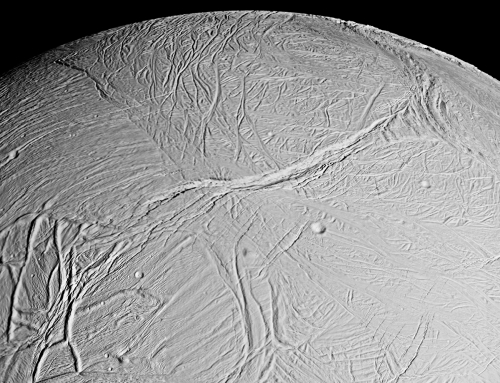
Image: What lies beneath… Now we learn that there is solid evidence for an ocean below this entire surface. Credit: NASA/JPL-CalTech.
Matthew Tiscareno, now at the SETI Institute after working on the Enceladus data at Cornell (he is a co-author of the just published paper), explains the significance of the finding for possible astrobiology:
“This exciting discovery expands the region of habitability for Enceladus from just a regional sea under the south pole to all of Enceladus. The global nature of the ocean likely tells us that it has been there for a long time, and is being maintained by robust global effects, which is also encouraging from the standpoint of habitability.”
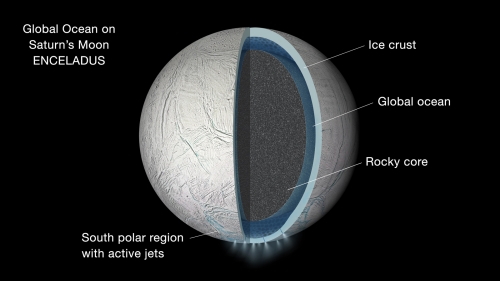
Image: This illustration is a speculative representation of the interior of Saturn’s moon Enceladus with a global liquid water ocean between its rocky core and icy crust. The thickness of layers shown here is not to scale. Scientists on NASA’s Cassini mission determined that the slight wobble of Enceladus as it orbits Saturn is much too large for the moon to be frozen from surface to core. The wobble, technically referred to as a libration, reveals that the crust of Enceladus is disconnected from its rocky interior. Credit: NASA/JPL-Caltech.
We’ve come a long way since the first Cassini discoveries of the plume of water vapor, ice and organic molecules erupting from Enceladus’ south pole. It was in 2009 that we learned by measuring the saltiness of the geyser particles that their source could only be a reservoir of liquid, and by 2014 it was possible to analyze the gravitational pull of the Saturnian moon on Cassini itself, which showed that at least a regional sea must be present under the ice.
Now we have a global ocean to deal with, although the question of how it remains liquid is still unresolved. Are tidal forces from Saturn’s gravity generating more heat than we realize? Much work remains as we try to answer that question. In the near term, Cassini is scheduled for a close flyby at the end of October in which it will pass a scant 49 kilometers above the moon’s surface. This ‘deep dive’ through Enceladus’ active plumes will be the closest yet. With a global ocean spewing material into space, the case for further work at Enceladus is overwhelming.
The paper is Thomas et al., “Enceladus’ measured physical libration requires a global subsurface ocean,” published online by Icarus on 11 September 2015 (abstract).

CubeSats: Deep Space Possibilities
The Planetary Society’s LightSail-A, launched on May 20 of this year, demonstrated sail deployment from a CubeSat despite software problems that plagued the mission. You’ll recall that communications were spotty and the upload of a software fix was compromised because of the spacecraft’s continued tumbling. After a series of glitches, the craft’s sail was deployed on the 7th of June, with LightSail-A entering the atmosphere shortly thereafter, a test flight that did achieve its primary objective, serving as a prototype for the upcoming LightSail-1.
Mixing CubeSats with solar sails seems like an excellent idea once we’ve ironed out the wrinkles in the technology, and as I’ve speculated before, we may one day see interplanetary missions carried out by small fleets of CubeSats propelled by solar sails. Although the LightSail-A demonstrator mission was in a low orbit, LightSail-1 will deploy its four triangular sails once it reaches an orbital altitude of 800 kilometers. A key reading will be what sort of increase in the spacecraft’s orbital speed is observed once it deploys its sail at altitude.
We’ll be watching this one with interest in April of next year, when it is scheduled to launch aboard a SpaceX Falcon Heavy, itself the object of great interest (this will be its first launch). Whether the launch goes on time will depend upon how well SpaceX recovers from the recent Falcon 9 launch failure. Whenever it launches, a successful LightSail-1 flight would lead to two more solar sail projects on The Planetary Society’s agenda, with LightSail-3 traveling to the L1 Lagrangian point, a useful position for monitoring geomagnetic activity on the Sun.
NASA, meanwhile, has CubeSat plans of its own, likewise dependent upon the health of a booster, in this case the Space Launch System (SLS) rocket. The first flight of the SLS, planned for 2018, will carry an uncrewed Orion spacecraft to a deep space orbit beyond the Moon and return it to Earth. It’s interesting to see that the first SLS mission, according to this NASA information sheet, has the ability to accommodate eleven 6U-sized CubeSats. The standard 10×10×11 cm basic CubeSat is a ‘one unit’ (1U) CubeSat, but larger platforms of 6U and 12U allow more complex missions (LightSail-1 is built around a 3U CubeSat format).
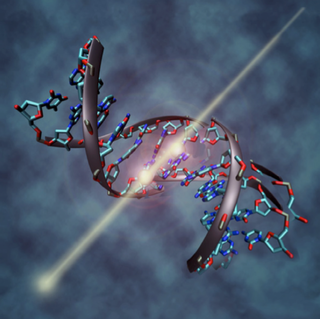
The future of CubeSats with NASA is confirmed by the Advanced Exploration Systems Division’s choice of three secondary payloads intended for SLS launch and a destination in deep space. BioSentinel is intriguing because it will mark the first time we’ve sent living organisms to deep space since the days of the Apollo missions. The organisms in question are yeast (S. cerevisiae), useful in studying DNA lesions caused by highly energetic particles. The idea is to operate in a deep space radiation environment for eighteen months, measuring the effects of radiation on living organisms at distances far beyond low Earth orbit. So far, the longest human mission in deep space was 12.5 days, accomplished by the crew of Apollo 17.
Image: Conceptual graphic of a radiation particle causing a DNA Double Strand Break (DSB). Credit: NASA.
Crews aboard the International Space Station have obviously spent far longer in space, but only in low-Earth orbit, leaving us with plenty to learn about the effects of deep space on biological systems. Another use of CubeSats will be to scout out important targets near our planet, which is the mission designed for NEA (Near-Earth Asteroid) Scout. Here we have another solar sail/CubeSat combination, allowing maneuvering during cruise for the approach to an asteroid. The plan is to study a small asteroid less than about 90 meters in diameter, homing in on a range of parameters including the asteroid’s shape, rotational properties, spectral class, local dust and debris field, regional morphology and properties of its regolith. Ideally these data will be used to resolve issues related to the eventual human exploration of NEAs.
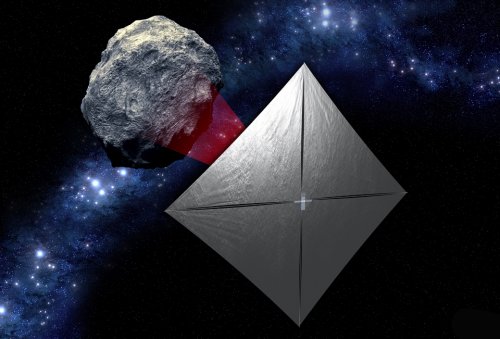
Image: Near-Earth Asteroid Scout, or NEA Scout, will perform reconnaissance of an asteroid using a CubeSat and solar sail propulsion. Credit: NASA/JPL.
Lunar Flashlight is the third approved mission, a solar sail craft with a 6U CubeSat intended for insertion into lunar orbit to look for ice deposits and areas best suited for resource extraction by future human crews. So this one is likewise a scout, one whose sail will be able to reflect 50 kW of sunlight and light up dark craters at the lunar poles where surface water ice may be lurking. It’s also the first mission that will attempt to fly an 80 m2 solar sail. Repeated measurements will give us a chart of ice concentrations in these regions, while also building a catalog of places rich enough in materials to support in-situ resource utilization (ISRU).
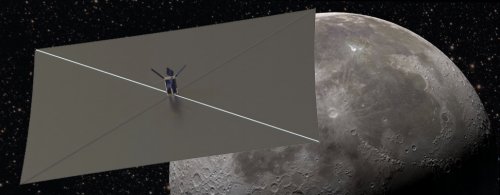
Image: Lunar Flashlight will map the lunar south pole for volatiles and demonstrate several technological firsts, including being the first CubeSat to reach the Moon, the first mission to use an 80 m2 solar sail, and the first mission to use a solar sail as a reflector for science observations. Credit: NASA/MSFC.
The CubeSats designed for the first SLS mission won’t get a lot of the publicity when the big rocket flies, but if they perform as expected, they’ll be pushing the small modular satellite concept into new areas. Particularly with regard to solar sails, NEA Scout and Lunar Flashlight should give us opportunities to navigate and maneuver with sails, building experience for the larger sail missions of the future. Meanwhile, Japan’s IKAROS sail, in its ten-month solar orbit, remains in hibernation, with its fifth wake-up call scheduled for winter of this year. Remember that a 50 meter sail, an ambitious successor to IKAROS designed for a mission to Jupiter and the Trojan asteroids, is in the works, with launch some time later in the decade.

Pluto/Charon: Complexities Abound
Given the flow of new imagery from New Horizons, I began to realize that mission data were changing my prose. To be sure, I still lean to describing the system as Pluto/Charon, because given the relative size of the two bodies, this really seems like a binary object to me. I tend to call it a ‘binary planet’ among friends because I still think of Pluto as a planet, dwarf or not. But when New Horizons blew through the Pluto/Charon system, it was finally possible to start talking separately about Charon, because now we were seeing it, for the first time, up close.
Charon as a distinct object from Pluto is a fascinating thought, one I’ve mused over since the days of the smaller object’s discovery in 1978. An enormous moon hanging in the sky, never changing its position, over a landscape unknown — the imagination ran wild. In the event, New Horizons outdid anything I ever conceived, with imagery of both worlds we’ll be debating for a long time. But in some ways my favorite of the images so far is the one just below.
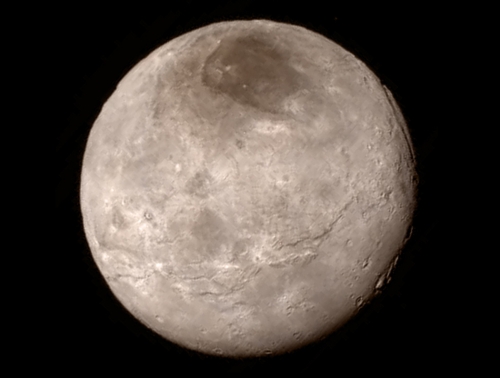
Image: Details of Pluto’s largest moon, Charon, are revealed in this image from New Horizons’ Long Range Reconnaissance Imager (LORRI), taken July 13, 2015, from a distance of 466,000 kilometers, combined with color information obtained by New Horizons’ Ralph instrument on the same day. The marking in Charon’s north polar region appears to be a thin deposit of dark material over a distinct, sharply bounded, angular feature; scientists expect to learn more by studying higher-resolution images still to come. (Credit: NASA/Johns Hopkins University Applied Physics Laboratory/Southwest Research Institute).
What’s striking about Charon at first glance is the darkening at the north pole, a phenomenon Carly Howett (Southwest Research Institute, Boulder) discussed in a recent blog article for NASA. Redder and darker it is, a circumstance Howett explains by reference to the surface composition of the northern polar region. A working theory is that traces of Pluto’s atmosphere reach Charon on occasion, where the gases come into contact with polar regions with temperatures between -258 and -213° C. This is a range not a lot higher than absolute zero (?273.15° C, or ?459.67° Fahrenheit).
Gases arriving at Charon’s winter pole would simply freeze rather than escaping, so we have a deposit of Pluto’s atmospheric nitrogen, with methane and carbon monoxide, gradually building up. This would not occur at Charon’s somewhat warmer equator. When the winter pole re-emerges into sunlight, solar radiation on these ices produces tholins, which form when simple organic compounds like methane are irradiated. With their higher sublimation temperature, these tholins cannot escape back into space. Howett sums it up this way:
Charon likely has gradually built up a polar deposit over millions of years as Pluto’s atmosphere slowly escapes, during which time the surface is being irradiated by the sun. It appears the conditions on Charon are right to form red tholins similar to those shown, although we have yet to figure out exactly why. This is one of the many things I am looking forward to better understanding as we receive more New Horizons data over the next year and analyze it in conjunction with continued laboratory work.
Tholin color depends on the ratios of the molecules involved and the kind of radiation received — various shades have been produced in the laboratory. We don’t find them on Earth outside of our own laboratories, but tholins are thought to be abundant on the icy objects in the outer system, usually taking on a reddish brown hue. You may recall they’ve also been discussed in relation to Titan, where we’ve learned from Cassini measurements that tholins appear higher in the atmosphere than was once believed (see Titan’s Tholins: Precursors of Life?). Think of them not as a single specific compound but a range of molecules with a generally reddish color.
Did tholin-rich comets play a role in delivering the precursor materials needed for life to develop on Earth? It’s a notion we can’t rule out, but for now what we can do is study tholins in the places they naturally occur, and in the case of Charon, we can see that they are part of a mechanism that can explain surface color variations. The object 28978 Ixion, a Kuiper Belt object in orbital resonance with Neptune, appears to be particularly rich in tholins.
Meanwhile, the flow of data from New Horizons in just the last few days has more than doubled what we can see of Pluto’s surface at the 400 meter per pixel level. We’re finding still more puzzles as we push deeper into the imagery, with features that appear to be dune-like, and what seem to be nitrogen ice flows and valleys that could have been carved by such flows over the surface. The processes at work should provide fodder for countless dissertations. Here’s one of the new images — for more, see New Pluto Images from New Horizons: It’s Complicated.
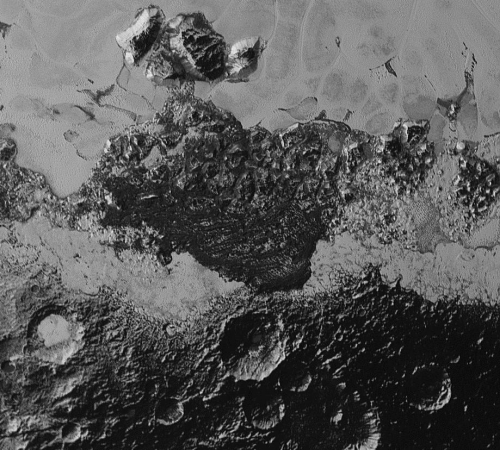
Image: This 350-kilometer wide view of Pluto from NASA’s New Horizons spacecraft illustrates the incredible diversity of surface reflectivities and geological landforms on the dwarf planet. The image includes dark, ancient heavily cratered terrain; bright, smooth geologically young terrain; assembled masses of mountains; and an enigmatic field of dark, aligned ridges that resemble dunes; its origin is under debate. The smallest visible features are 0.8 kilometers in size. This image was taken as New Horizons flew past Pluto on July 14, 2015, from a distance of 80,000 kilometers. Credit: NASA/Johns Hopkins University Applied Physics Laboratory/Southwest Research Institute.
“The surface of Pluto is every bit as complex as that of Mars,” said Jeff Moore, leader of the New Horizons Geology, Geophysics and Imaging (GGI) team at NASA’s Ames Research Center in Moffett Field, California. “The randomly jumbled mountains might be huge blocks of hard water ice floating within a vast, denser, softer deposit of frozen nitrogen within the region informally named Sputnik Planum.”
Heavily cratered terrain next to young icy plains, with the suggestion of dunes on a place whose atmosphere should be too thin to produce them. No wonder William McKinnon (Washington University, St. Louis) calls the latter a ‘head-scratcher.’ The surfaces of Pluto and Charon have delivered complexities galore, and we’re only now learning that Pluto’s atmospheric haze is far more complex than earlier thought, offering a twilight effect that helps light nightside terrain. “If an artist had painted this Pluto before our flyby, I probably would have called it over the top,” says New Horizons principal investigator Alan Stern, “but that’s what is actually there.”
And then there’s this (brought to my attention by Larry Klaes):
OMG! Pluto never disappoints. Who said a picture=1000 words? I just saw a new one worth maybe 1000 scientific papers! #OMG #Plutoflyby
— NewHorizons2015 (@NewHorizons2015) September 13, 2015


